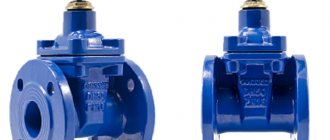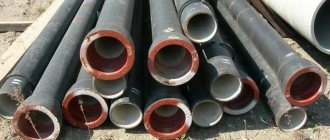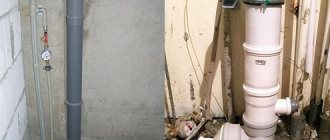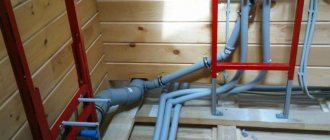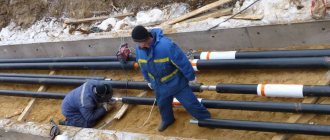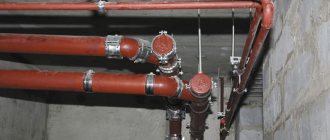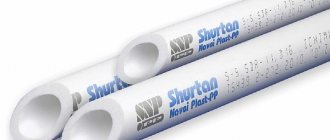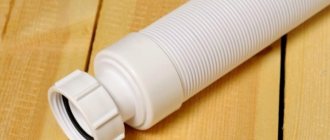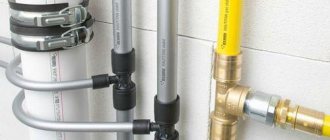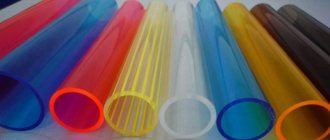When installing a sewer system, it is necessary to comply with a number of requirements regarding the methods of its installation; one of the main ones is the convenience of carrying out preventive, inspection and cleaning work. It is for these purposes that a sewer inspection is intended, which is a mandatory element of any sewerage system.
When installing sewer lines by specialists or laying sewer lines yourself, it is useful to know the rules for placing and installing revisions. And in order to make the best choice from a number of models presented in the retail chain, you should study their design structure and the range presented.
Rice. 1 Examples of placement of sewer inspections on vertical risers
What is an audit?
In old cast iron pipelines, the inspection was a rectangular window, closed with a sealed lid. The flange tee cover was secured with four bolts. The use of pipes and connecting elements made of cast iron is practically irrelevant today. Metal products compete with plastic ones, whose characteristics are superior in terms of quality. The audit for sewers has also undergone changes in form. Replacing the rectangular hole with a round one simplified the production of the part and its operation.
Modern model of sewer inspection, widespread abroad Source serviceoptk.ru
Differences between plastic sewer inspection
Inspections for plastic sewer pipes are very different from cast iron ones. At first, buyers noted only a change in material, but manufacturers also made several design changes. These are the ones that should be studied, giving a detailed description:
- The bend on the plastic revision is installed at a right angle, and on the cast iron revision it is mounted at an angle of 45 degrees.
- The lid screws tightly without bolts, as on cast iron structures.
Both features suggest that it is easy to install an additional element on a 110 pipe. To do this, simply insert the fitting into the cuff without wasting time. Professionals definitely use such projects, and not only because of the current SNiPs.
Main types and sizes
Cast iron pipeline elements are still in use in old buildings where the sewage system has not been replaced with a plastic one. The revision cover of the new sample differs from its metal counterpart. It has a round shape and is fixed to the outlet using a thread. While the cast iron cover is pressed against the hole with bolts, and a rubber gasket is used to seal the connection. The modern revision is convenient and reliable to use.
Today, sewer inspection is made from:
- polypropylene;
- cast iron;
- PVC.
The polypropylene pipeline element has good performance characteristics. Revision made of polypropylene has a number of advantages, namely:
- tolerates temperature changes well, up to 95°C;
- not prone to destruction due to mechanical impact;
- service life reaches 50 years.
It is important to choose the correct location for the inspection, otherwise cleaning the sewer will be difficult. Source ukcet.ru
Polypropylene inspections are made for pipes with a radius of 55 mm, intended for the installation of risers and toilets, and with a radius of 25 mm - for horizontal pipelines connected to sinks and bathtubs.
The sewer system can use the so-called. cleaning, which serves to eliminate blockages. The characteristic design with an inclined outlet allows the cable to be directed only in a given direction. Typically, cleanouts are installed at the end points of the system. The absence of a lid is replaced with a plug, which is fixed with mastic. The inspection can be used not only to combat blockages, but also to repair the pipeline. Also, the structure of the element allows you to change the direction of the cable for cleaning. The absence of a characteristic inclined bend in the revision will help to distinguish similar parts.
Cast iron revisions have a number of features:
- rectangular hatch;
- minimum pipe diameter from 80 mm;
- fixing the cover with four bolts that are tightened crosswise. The nuts are tightened with an adjustable or open-end wrench;
- The rubber gasket on the hole ensures the tightness of the connection.
The best inspection location is considered to be a long straight section of the sewer pipeline Source 7stroiteley.ru
Features of use
The operation of the audit is sporadic. There are many elements that have never been used during their entire service life, so home craftsmen have no experience working with such devices. There are no fundamental requirements for the use of revisions, the only condition is accuracy and attention - it is easy to damage the edges of the outlet with a cable, which will break the tightness of the connection between the cover and the pipe. This can cause a bad odor and leaks, which will require labor-intensive replacement of the entire element. During cleaning, you should take into account the danger and act as carefully as possible, then the result of the work will be fully expected and favorable.
What is cleaning
Cleaning is analogous to an audit. It looks like a tee, one of the holes of which is made at an angle. The angle of retraction relative to the center is 45°. Cleaning is necessary to remove blockages in the sewer system. The element is installed in a horizontal or vertical position, taking into account the direction of water movement. The side hatch is closed with a sealed plug. Blind areas located at the beginning or end of the sewer system or areas where the direction of the pipes change are selected as the cleaning installation location. Cleaning differs from inspection by the presence of an inclined outlet, which allows you to clean the sewer in only one direction.
The appearance of cleaning is a special case of an inspection sewer fitting, which allows cleaning and inspection in only one direction Source gid-str.ru
Passing the riser through the ceilings
To pass through the floors, a hole is made at the place where the sewer riser is installed, allowing the riser to be wrapped with rolled waterproofing and the passage to be sealed to the full thickness of the floor with cement mortar.
The section of the riser above the ceiling by 8-10 cm is also sealed with cement mortar. The thickness of the protective layer of cement mortar should be 2-3 cm.
The passage of the sewer riser through the reinforced concrete ceiling is shown in the figure:
***As you can see, laying internal sewerage does not present any particular difficulties and can be done independently if you follow the recommendations given in the article.
In the following publications we will talk about sewer repair, clearing blockages and replacing pipe sections if necessary. We will also learn how to select and install a septic tank and how to carry out all the work on installing an external network.
Bookmark the site so you don't miss new useful publications.
Share this page with your friends on social networks:
When constructing a log house, it is almost impossible to avoid gaps between the logs or beams from which the crowns are assembled. Even when building a log house from rounded logs processed on a machine, it is not possible to fit the crowns to each other tightly enough to... Read.
In order for interior wooden finishing to please the eye with its beautiful appearance for many years, the wood must be treated with a special composition that will prevent wood-boring insects from eating the wood, and will also be able to withstand the effects of... Read.
Many bathhouse owners believe that strong hot steam can cope with any ailment and in case of any illness they advise going to the steam room to warm up properly. But is this really so and is it possible to visit the bathhouse with purulent inflammation of the maxillary sinuses... Read.
Installation Rules and Regulations
When installing an inspection, if it comes to underground pipe laying, it is mandatory to install an inspection well. For the installation of external sewerage, pipe options are used that can withstand significant temperature changes and are not damaged by frost heaving. As a general rule, pipes are laid at the depth of soil freezing, determined for each settlement separately.
Wells are located evenly along the entire length of the system:
- every 3-5 m on slopes;
- every 8-10 m on level areas.
In multi-storey residential and office buildings with more than five floors, a sewerage inspection is installed on every third floor. In buildings with fewer storeys, the element is placed on the first and last floors.
Sewer slopes
Sewer pipes must meet two necessary conditions - to freely pass the probable flow of waste liquid and not to become silted due to sediments accumulating on the internal walls.
To pass the flow rate, the appropriate diameters are selected, but to comply with the second condition, the minimum slopes are calculated to ensure the movement of the waste liquid at the so-called non-silting speed. In other words, at such a flow speed, smoothness of the pipe walls and slope, all contaminants slip into the pipe without being deposited on the walls.
The slope values are given in the table above.
In cases where it is not possible to maintain a normal slope, it is allowed to lay pipes with a minimum slope.
You can approximately determine the minimum slope for any diameter offhand as follows - divide the unit by the pipe diameter in millimeters. That is, for a pipe with a diameter of 100 mm, the minimum slope that ensures that the pipe does not silt at the design flow rate with sufficient filling of the working section of the pipeline will be:
For a pipe with a diameter of 200 mm, the minimum slope will be 1.200 = 0.005.
This method of determining the slope is convenient to use for a quick approximate calculation of the design elevations along which the pipeline will pass when installing an external network. After all, the depth of the wells and the ability to maintain the distance to the standard freezing depth in the area where the sewage system is laid will depend on this.
But do not forget that this way you can determine the smallest possible slope. Normal slopes should be taken according to standard values, which are the following values for different diameters: D100 – 0.02 D150 – 0.01 D200 – 0.008
We also recommend watching a video about the slopes of internal sewers:
Installation
The installation of the audit proceeds according to the following plan:
- After determining the placement height, the pipe diameter is cut with a hacksaw or grinder.
- Using sandpaper, chamfer the outer part of the pipe, and also remove burrs formed after trimming.
- The sewer inspection is washed and placed in the lower pipe.
- The next part of the riser is inserted into the upper branch of the inspection tee. The process continues in the same way until installation is complete.
Methods for inserting outlets from household appliances
It is this problem that often causes sewer connections. Moreover, it occurs not only in houses with old layouts, but also in new apartments designed taking into account modern operating conditions. It is in such houses that the pipe in the bathroom, where the washing machine is installed, is concreted into the wall. So it turns out that it is easier to make an insert than to install a new siphon with seven ensuing consequences.
To work you will need the following tools:
- Metal strip, drill and large diameter drill bit.
- A clamp intended for fastening the outlet.
- FUM tape.
The work is carried out in the following sequence:
A clamp is placed on the outlet, intended for fastening metal strips. To fix the clamp on the wall, you need to drill holes in it. Since a connection is made into a pressure sewer, it is necessary to let water through. This action will avoid the appearance of a foul odor. A hole is drilled in the pipe. If you cannot find a drill of a suitable diameter, then for further work you will need a sharp knife or file. They can be used to widen the hole.
It is important to understand that the hole must remain round, and its diameter can only be two millimeters less than the identical parameter in the outlet. The outlet is wrapped with FUM tape and inserted into the hole. There is no need to try to save on the tape and, if necessary, it is better to rewind it completely for reliable fixation. Places for attaching metal strips are marked on the wall, holes are drilled in them and dowels are screwed in
The fastener is twisted with maximum density in order to tightly and securely fasten the clamp to the outlet.
The last step is to coat the edges of the joint with sealant. As soon as the lubricant hardens, an additional connecting layer is formed at the joint.
Inserting an inspection into the riser pipeline
Sometimes it becomes necessary to install a revision on a system that is already mounted. Regardless of the location of the pipeline, a plumber cannot do without an additional element - a repair coupling or expansion pipe.
Installation of the inspection tee in the riser is carried out according to the following plan:
- Determine a section of the sewer system suitable for placing an inspection. The fragment is trimmed and dismantled. Prepare 1-2 pipes to install the element between them.
- The smooth end of the revision is inserted into the socket of the pipeline. When installing, pay attention to the condition of the sealing ring. Loss of elasticity and deformation are indications for its replacement.
- Where the pipe is cut, it is necessary to process the cut with sandpaper, since burrs can damage the O-rings. Another pipe is put on the polished section of the working pipe and installed as deep as possible.
- The inspection tee is inserted into the socket of the lower pipe. Then the machined end of the upper pipe is inserted into the socket of the installed element.
- Using sealant at the joints will eliminate possible leaks. After the substance has hardened, the system is started in trial mode.
Vertical sewer risers can be of considerable length; installing an inspection allows you to avoid many problems Source masterfibre03.ru
Material of manufacture and technical characteristics
Before purchasing plastic pipes for sewerage or water supply installations, you need to pay attention to the technical characteristics of the material and weigh the pros and cons
Polypropylene pipes
Socketed polypropylene pipes
Polypropylene is produced in the form of granules, from which pipes of different diameters are cast during heat treatment. PP does not chemically interact with acids and alkalis, does not emit harmful substances, therefore it can be used in cold and hot water supply systems. The material becomes soft at 145 degrees, so it can withstand hot drains up to 95 degrees without deformation.
Physical and mechanical parameters:
- resistant to mechanical shocks;
- low temperatures have no effect if ethylene is added to the molecules;
- wear resistant;
- Aluminum-reinforced polypropylene deforms less when heated;
- sensitive to oxygen and ultraviolet radiation - to reduce the performance, stabilizers are added to the composition.
Depending on the filling, you can create a material with new properties:
- Glass filled. Fiberglass increases bending elasticity and increases the strength of finished products.
- Mineral-filled. The introduction of calcium carbonate increases the thermal insulation properties of PP.
- Elasticated. By adding elastomers, the frost resistance of pipes and their elasticity when bending increases.
- Low-flammability. Produced by mixing granules with antiprene. If a fire occurs, the material extinguishes on its own.
Plastic pipes made of polypropylene are much cheaper and more practical than metal ones. They have a smooth inner surface, which prevents dirt from sticking and clogging the drain. Mineral sediments - calcium, iron - are not able to clog the lumen and change the diameter of the pipes, because the material is not electrified and does not attract salt molecules. It is recommended to install filters for drinking water if it contains dissolved minerals, as they can damage household appliances - dishwashers and washing machines, boilers, boilers or radiators.
PVC pipes for sewerage
PVC pipes
Unplasticized polyvinyl chloride is a material that successfully replaces steel structures, which are much more complex and expensive to maintain. It is used in the food and chemical industries, since PVC can withstand aggressive loads from acids - nitric, hydrochloric, sulfuric, and does not release harmful substances into the transported liquid.
Characteristics:
- low expansion coefficient when heated;
- the material begins to soften at 80 degrees;
- melts at 180 degrees;
- In warm weather, it is shock resistant.
The disadvantage of PVC is that fragility increases with decreasing temperature.
Polyethylene pipes
Polyethylene sewer pipes
High-density polyethylene is used to make pipes. The service life of the material is about 50 years. This is much longer than pipes made of concrete, metal or cast iron last.
Advantages of polyethylene pipes for sewerage:
- do not deteriorate upon contact with water or aggressive liquids;
- environmentally friendly;
- welding does not require additional consumables, as for steel;
- the installation process takes less time due to the relatively light weight of the products;
- elastic – withstands pressure and temperature without cracking or deforming;
- the ice that forms inside the pipe does not damage it;
- Suitable for installation in areas where there is a high load on the ground and where earthquakes occur frequently.
Cross-linked polyethylene
Cross-linked polyethylene
Not inferior in strength to solid substances. It is obtained by adding peroxides, silane, and nitrogen.
Advantages of cross-linked polyethylene over regular polyethylene:
- thermal insulation properties are 30% higher;
- resistant to ultraviolet radiation and atmospheric conditions, therefore can be used for arranging open water pipes;
- high mechanical tensile strength, as well as flexibility of the material;
- shockproof in frosts below 50 degrees.
Features of external installation of inspection in horizontal sections
The sewer system in the private sector involves its connection to an autonomous sewer system, which is represented by storage tanks or a septic tank. If waste collection facilities are more than 12 m away from the building, SNiP 2.04.01-85 requires the home owner to organize an inspection of the pipeline system.
Inspection wells provide access to the inspection and protect it from environmental influences. The depth of the well depends on the height of the pipe connecting the sewer pipe to the septic tank. The minimum depth must be at least 600 mm. The width of the inspection well must correspond to the size necessary for free access to the inspection unit.
Corrugated pipes and reinforced concrete rings are used as materials for making wells. The latter are used more often. The installation of the rings is completed by installing the polymer hatch. This durable and lightweight material does not deform even under the weight of the car.
Maintenance of sewer pipelines of a private house is impossible without installing inspections Source istra-gaz.ru
Wells made from sections of corrugated pipes are characterized by a long service life and ease of installation. However, excessive plasticity together with high cost do not allow the use of such wells for installation of inspections in private homes.
Exploitation
Access to the inspection must always be free.
Blockages are formed from rags dropped into the toilet, dumped contents of cat litter boxes, sand and household waste.
To remove the plug, an inspection located upstream of the water flow is used. It is opened and cleaning begins using the rotational movement of the cable. During the event, you should ensure that it takes place without the formation of loops. The rags are wrapped around the device and pulled out. In case of operational blockage, it is recommended to flush several buckets of hot water down the drain after cleaning to check. Water is supplied directly into the hatch of the device, since it has time to cool on the way from the installed plumbing.
To carry out cleaning activities in an apartment building in the absence of residents from the lower floors, audits are installed in the basements.
If during operation problem areas are identified where debris collects, a new hatch is installed: the sewer pipeline is cut off above the socket, the cut is cleaned of irregularities, the chamfer is removed and an inspection is installed in the extension. For subsequent connection, use a pipe.
In old houses, the bolts on cast iron hatch doors rust, so they are cut off with a grinder and, after cleaning, replaced with brass ones. If the bolts are not at hand, the cover is tightened with wire. The rubber gasket can be made from a car inner tube.
Standards
Sewer inspection is a mandatory pipeline element for installation, the need for which is established by the requirements of building codes and regulations. Installation of the audit according to regulatory documents is carried out by:
- in multi-storey buildings higher than 5 floors, where inspection units are placed at intervals of 3 floors;
- on the lower and upper levels of a low-rise building;
- in a horizontal sewer system with a pipe diameter of 50 mm, inspections are placed at intervals of 15 meters;
- on horizontal sections of the pipeline connecting more than three plumbing fixtures and not having another element to control blockages;
- in sewer systems with domestic wastewater, the length of the pipe section between inspection and cleaning should not exceed 12 meters;
- at a distance of no more than 10 meters for sewerage with industrial wastewater or storm water.
Monitoring compliance with the number of inspection holes is carried out at the project stage by entering it into the working drawing of the pipeline.
If the sewer pipe is deep, inspection wells must be installed Source eurolos.ru
How to choose the right drain pipe diameter
Even at the stage of the initial design documentation, the dimensions of the sewer pipes in the future building must be agreed upon. In 90% of cases, parts with a diameter starting from 100 mm are used to install a wastewater system in a bathroom. To install the system in the bathroom or kitchen, it will be enough to use a 50 mm pipeline. The difference in the given values was chosen for a reason. It is determined by several factors:
- A toilet is a plumbing fixture, the peculiarity of which is the passage of a significant volume of water in a short period of time (when the flush button is pressed). At the same time, the water may contain solid particles, which will be problematic for elements of the waste structure with smaller circumferences than those given above to cope with. There is a high probability of blockages.
- Even without looking at the fact that when draining water from a bathtub, its volume is no less than the volume of water from the toilet, the diameter of the sewer pipe will be smaller due to a simple rule of hydraulics - the permeability of the system should be equal to the value provided in the place with the narrowest circumference parameter. This release value in the bathroom is significantly less than in the toilet. Therefore, it is impractical to mount parts with a large diameter.
Required pipe slopes (Example - 1:30. Where 1 linear meter per 30mm slope)
Basic principles of eliminating blockages using revision
The sewer system becomes clogged when grease, rags, bulk substances in the form of sand or filler for trays, as well as the remains of construction mixtures get into the pipe. The blockage is cleared through an inspection window located above the clogged section of the pipe. The blockage is removed using a cleaning cable or a hydrodynamic pipeline flushing device.
Hot water is used to remove fat plugs. After neutralizing the blockage caused by the accumulation of sand, filler or construction debris, flush a large amount of water down the toilet. Large debris is pulled out with a plumbing rope.
A plastic inspection well-tee allows you to avoid constructing a caisson made of concrete rings Source kanalizaciya-expert.ru
Purpose of sewer inspection
Inspections for external sewerage made of plastic
When removing a garbage plug that has blocked a cross-section, an inspection of the sewer riser is used. Purpose of the device: to provide access for quickly removing blockages using cables or steel wire, which allow you to break through the obstacle and clear the drains without disassembling the pipeline.
The element is a part of a pipe in the form of a tee, which has a hole with a closing lid, through which stuck debris is removed using various devices. The audit is installed inside or outside the house. If for some reason you forgot about the inspection hatch when installing the sewer system, cleaning will require dismantling or damage to the pipeline, resulting in leaks and an unpleasant odor in the living room.
Description
Inspection-cleaning for pipes made of PVC or PP is used to organize access to hidden wiring of sewer lines and access to horizontal and vertical sewer risers, if necessary, for their maintenance and cleaning. The cleaning inspection has a decorative stainless steel cover that can withstand external mechanical loads. The inspection-cleaning outlet pipe is designed for connection with any sewer socket pipe made of PVC or PP (REHAU, WAVIN, etc.) of the appropriate diameter.
Sewerage installation in the house and bathhouse
In the previous publication we looked at sewer pipes. which are used in modern construction for the installation of drainage networks. As you now know, pipes differ in material and diameter, and can also be used for external and internal installation.
External sewerage schemes. which are most often used in individual suburban construction, we discussed earlier, but now let’s see how to properly make an internal sewer system in a bathhouse or house so that it serves you faithfully for many years.
We will find out which pipes are best to use for this, and also talk about the recommended angles of inclination for draining wastewater and some tricks that you need to know when starting installation.
Providing sound insulation
Additionally, you can take measures to soundproof the sewer riser; they will be useful both in a private house and in an apartment.
Noise in the sewer can occur for a number of reasons, namely:
- When wastewater hits the walls of the pipeline;
- Penetration of foreign air into the system;
- Contact of pipes with walls or ceilings.
Soundproofing work will help eliminate noise-related inconveniences. This can be done in different ways:
- Installation of risers from special pipes. Of course, this measure is mainly used in the process of replacing an existing sewer system or laying a new one. Such products are distinguished by increased wall thickness and high density of the manufacturing material;
- Use of soundproofing materials. Most often, roll insulation or foamed polyethylene is used for this;
- The use of a special insulating “shell”. It is a finished product that is mounted on a laid pipe;
- Installation of the box and lining it from the inside with mineral wool.
Sound insulation work using roll materials includes the following actions:
- It is necessary to check the tightness of the joints, clean and degrease the surface of the riser;
- Apply vibration-damping material and roll it on top with a regular paint roller;
- Wrap the pipe with rolled sound insulation, securing it with flexible clamps (craftsmen often call them ties).
Installation of a soundproofing plasterboard box is carried out as follows:
The pipes are carefully checked for leaks, because if a leak occurs, the entire structure will have to be disassembled; Wrapped with rolled soundproofing material; Markings are being made for the future box
Please note that its walls should be 50-60 mm away from the surface of the pipe; A frame made of a metal profile is installed, with horizontal jumpers attached every 400-500 mm; We begin to install drywall, it is better to give preference to moisture-resistant. After one side is assembled, we lay mineral wool and sew up the remaining part.
Preparing for sewer cleaning
When sewer pipes become clogged, effective means to achieve a positive result are: an electric drill, a rope drill or steel wire. Cleaning begins in the following order:
- You can determine the location of the plug by lightly tapping (if you have access to a communication sewer). A dull sound will occur at the location of the plug and a little higher;
- If access to the pipe is difficult or it is located in the floor (with horizontal sewerage), the location of the blockage is determined by checking the inspection hatches;
- You need to start cleaning the pipes by getting as close as possible to the formation of a blockage (by determining the location of the nearest hatch);
- It is necessary to eliminate contamination in the hatch that is directly connected to the problem area;
- Wait a while (after the last use of the sewer). Because when cleaning the bottom hatch, above which drains have accumulated, stagnant dirty water may gush out.
